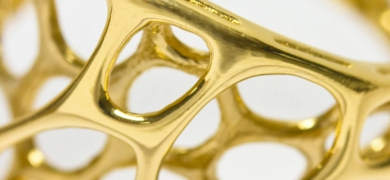

EOS M 300-4
DMLS Quality With up to 10x More Productivity
Different degrees of automation for individual requirements
Consistent part quality over the entire build space
Up to four precision fiber lasers cover the entire 300 x 300 mm area
Automation
The EOS M 300-4 enables flexible adaptation to all individual requirements through various degrees of automation, helping to ensure an optimized workflow.
Quality
The exceptional laser and performance stability ensures consistent part quality over the entire build space, including full coverage of overlaps.
Productivity
Up to four precision fiber lasers work over a 300 x 300 mm area, with each laser covering the entire space.
Technical Data EOS M 100
- Construction Volume
- 300 x 300 x 400mm (11.8 x 11.8 x 15.8 in)
- Laser Type
- Yb-fiber laser; 4 x 400 W
- Precision Optics
- 4 F-theta-lenses; 4 high-speed scanners
- Scan Speed
- up to 7.0 m/s (23 ft./sec)
- Focus Diameter
- approx. 100 µm (0.004 in)
- Power Supply
- 3 x 80 A
- Power Consumption
- max. 36 kW / typical 26 kW
- Compressed air supply
- 7,000 hPa; 15 m³/h (102 psi; 530 ft³/h)
- Machine Dimensions (W x D x H)
- 5,221 x 2,680 x 2,340 mm (205.6 x 105.5 x 92.1 in) (with EOS Transfer Station M)
- Recommended Installation Space
- min. 8,800 x 5,200 x 3,500 mm (346.5 x 204.7 x 137.8 in)
- Weight
- approx. 5.500 kg
- Software
- EOSPRINT 2, EOS ParameterEditor, EOSTATE Monitoring Suite, EOSCONNECT Core, EOSCONNECT Core, EOSCONNECT MachinePark, Materialise Magics Metal Package and modules.
Compatible materials
 3D Printing in Practice
3D Printing in Practice
Additive Manufacturing for Serially Produced Vehicles
We help our customers implement additive manufacturing wherever it can fully demonstrate its strengths. This ranges from major changes to logistics systems, detailed equipment customization and lightweight parts, to engine technology fine-tuning. 3D printing technology holds the potential to optimize the automotive production value chain and react quickly and flexibly to new trends. This potential is extremely valuable in an industry where every player, automotive manufacturer, OEM and tooling provider faces high costs and innovation pressure.
More information → 3D Printing in Practice
3D Printing in Practice
More Energy Efficiency With Additive Manufacturing
For many applications, sophisticated cooling technology is important. For gaming PCs, data centers, automobiles, LED modules, the chemical industry and many more; wherever you need to dissipate heat, heat exchangers and cooling elements are essential. Their size is often a challenge. For example, hand-held electronic devices need to house increasingly powerful technology that requires cooling. In addition, they need to integrate new functionality quickly, meaning that the heat problem needs to be solved again and again. This quickly pushes conventional production processes to their limits.
More information → Gold, Silver, Platinum and Palladium
Gold, Silver, Platinum and Palladium
Digital Production of Jewelry & Watches
Using CAD model data, 3D printers are used to build elegant jewelry articles layer by layer – without the process leaving any recognizable marks behind. The appearance of the finished products rivals artisanal blacksmithing in every regard. AM also allows the reduction in the cost of materials. By integrating empty spaces into the design, work pieces can be made more cost-efficiently and easily in a manner that saves resources.
More information →

